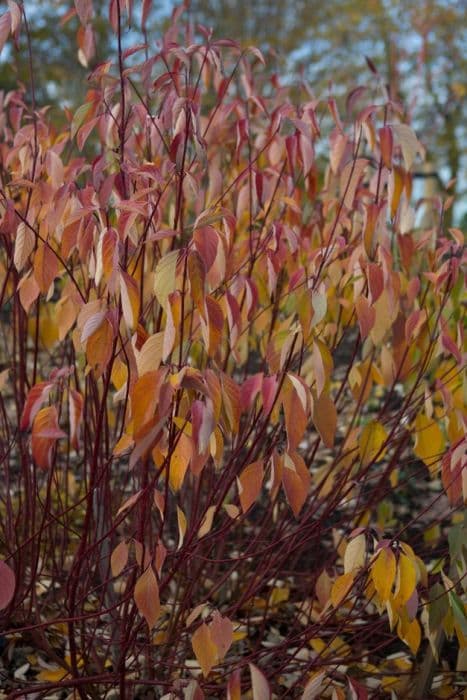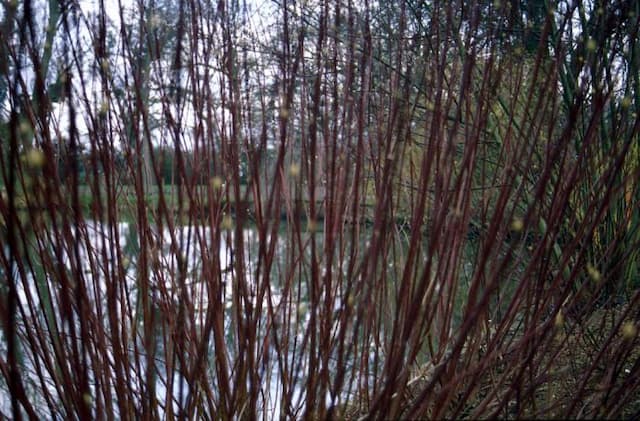Mapleleaf Alangium Alangium platanifolium

ABOUT
Alangium platanifolium, commonly referred to as the maple-leaved alangium, is a plant that exhibits deciduous behavior, shedding its leaves seasonally. The leaves of this plant are one of its most distinguishing features, as suggested by its common name; they are broad, resembling the shape of maple leaves and have an intricate vein pattern. Typically, the foliage flaunts a vibrant green hue that can change to striking shades of yellow or red, adding a splash of color before the leaves fall. The flowers of the maple-leaved alangium are noteworthy as well, often being showy with a tubular shape and usually coming in colors such as white or cream, which can attract various pollinators. The blooms may be arranged in clusters, adding to the visual appeal of the plant when in blossom. Adding to its ornamental value, the plant produces fruits that can be quite intriguing to the eye. These fruits usually take on a berry-like form and may change color as they mature, possibly transitioning through shades of green to darker tones like blue or purple-black when fully ripe. The bark of this species is another characteristic component, usually textured and might display an array of earthy colors which can range from grays to browns. This provides an aesthetic contrast to the more vibrant leaves and flowers, while also serving as a natural canvass that highlights the changing seasons marked by the transformation of the plant's foliage. Altogether, the maple-leaved alangium is valued for its decorative properties, with aesthetically pleasing leaves, showy flowers, attractive fruits, and distinctive bark, all contributing to its charm and making it a desirable plant for ornamental purposes in gardens or parks.
About this plant
 Names
NamesFamily
Alangiaceae
Synonyms
Maple-leaved Alangium, Hackberry-leaved Alangium
Common names
Alangium platanifolium subsp. trilobum, Alangium trilobum, Marlea begoniifolia, Marlea platanifolia, Marlea tomentosa, Marlea triloba.
 Toxicity
ToxicityTo humans
Alangium platanifolium, commonly referred to as the "Maple-leaved alangium," is not widely reported to be toxic to humans. However, absence of reports does not inherently mean that it is safe to ingest. If you suspect poisoning from any plant, it is important to seek medical attention.
To pets
Maple-leaved alangium is not well-documented for its toxicity to pets. Like with humans, the lack of information does not guarantee that it is safe for animal consumption. If you believe your pet has ingested this plant and is showing signs of distress, it's advisable to contact a veterinarian immediately.
 Characteristics
CharacteristicsLife cycle
Perennials
Foliage type
Deciduous
Color of leaves
Green
Flower color
White
Height
20 feet (6.1 meters)
Spread
15 feet (4.6 meters)
Plant type
Tree
Hardiness zones
5
Native area
Asia
Benefits
 General Benefits
General Benefits- Ornamental Value: Alangium platanifolium, commonly known as Hackberry, is often used for decorative purposes in gardens due to its attractive foliage and form.
- Shade Provider: The plant produces a wide canopy that can offer pleasant shade, making it useful for landscape designs in parks and large gardens.
- Wildlife Support: Hackberry can serve as a food source for birds and other wildlife, including various insects and small mammals which feed on its fruit and flowers.
- Erosion Control: The root system of Alangium platanifolium helps stabilize soil and can be beneficial in preventing erosion, especially on slopes.
- Low Maintenance: Hackberry plants are often low maintenance, requiring minimal care once established, making them suitable for less attentive gardeners.
- Drought Tolerance: The plant is quite tolerant to drought conditions once it is well-established, making it suitable for dry and arid environments.
- Windbreak: With their sturdy structure, Hackberries can act as windbreaks, offering protection to nearby plants and structures from strong winds.
 Medical Properties
Medical Properties- Antipyretic: Alangium platanifolium has been used traditionally to reduce fever.
- Anti-inflammatory: It may possess properties that help in reducing inflammation.
- Analgesic: The plant has been known to be used to relieve pain.
- Antitussive: It is sometimes used to alleviate coughing.
- Wound healing: There is traditional usage of the plant for promoting the healing of wounds.
- Antidiarrheal: Alangium platanifolium may be used to help treat diarrhea.
- Emetic: In some traditional medicine systems, the plant has been used to induce vomiting.
 Air-purifying Qualities
Air-purifying QualitiesThis plant is not specifically known for air purifying qualities.
 Other Uses
Other Uses- Woodworking: The wood of Alangium platanifolium is appreciated for its fine grain and can be used in cabinet making and intricate woodworking projects.
- Dye Production: The bark of the plant has traditionally been used to produce a natural dye for textiles.
- Fishing Aid: The seeds have been utilized in some cultures to poison fish, making them easier to catch.
- Agriculture: Because of its hardy nature, the plant can be used in agroforestry practices to protect smaller, more vulnerable plants.
- Folk Crafts: The branches and twigs can be woven into baskets and other folk craft items.
- Gardening: The tree's ornamental leaves make it a popular choice for gardens and parks where it can provide ample shade.
- Erosion Control: Its extensive root system helps stabilize soil and prevent erosion, particularly on slopes and riverbanks.
- Beekeeping: Flowers of the Alangium platanifolium can attract bees and thus be helpful in beekeeping and pollination.
- Culinary Accessory: The leaves are sometimes used as food wrappers for cooking in some regional cuisines.
- Ornithology Assistance: The tree provides nesting sites and habitat for various bird species, offering great opportunities for bird watching and study.
Interesting Facts
 Feng Shui
Feng ShuiAlangium platanifolium is not used in Feng Shui practice.
 Zodiac Sign Compitability
Zodiac Sign CompitabilityAlangium platanifolium is not used in astrology practice.
 Plant Symbolism
Plant Symbolism- Resilience: Alangium platanifolium, commonly known as the 'Hackberry', often symbolizes resilience as it can withstand harsh conditions and poor soils, representing the ability to endure and thrive in challenging circumstances.
- Protection: In some cultures, the Hackberry may be seen as a symbol of protection due to its sturdy and robust nature, suggesting a safeguard against adversity.
- Healing: Given its use in traditional medicine, the Hackberry can be associated with healing, denoting restoration, and recovery.
- Adaptability: The adaptability of Hackberry to different environments might render it a symbol of flexibility and the ability to prosper in various conditions.
 Water
WaterThe Mapleleaf Alangium should be watered when the top inch of soil feels dry to the touch, typically every one to two weeks, depending on the environmental conditions. Use room temperature water, pouring slowly at the base of the plant until the water begins to run through the drainage holes, indicating that the soil is thoroughly moist. In terms of frequency, during the growing season in spring and summer, water the plant more frequently, and reduce watering in fall and winter when the plant's growth slows down. Generally, you might use about half a gallon of water for a medium-sized potted plant each time you water, but this will vary based on the size of your plant and pot.
 Light
LightMapleleaf Alangium thrives in a position where it receives full sun to partial shade. The ideal spot for the Mapleleaf Alangium would be an area that gets at least four to six hours of sunlight a day. Avoid placing it in deep shade or direct, harsh afternoon sunlight, as this can either lead to underdevelopment of the plant or cause leaf scorch, respectively.
 Temperature
TemperatureMapleleaf Alangium prefers moderate temperatures typically found in a temperate climate. It can withstand a minimum temperature of around 25 degrees Fahrenheit but is happiest between the range of 60 to 75 degrees Fahrenheit. While mature plants can survive short periods of lower temperatures, extended exposure to freezing conditions or temperatures above 90 degrees Fahrenheit may harm the plant.
 Pruning
PruningPrune the Mapleleaf Alangium to maintain its shape and remove any dead or damaged branches, which will promote healthy growth and airflow. The best time to prune is in late winter or early spring before new growth begins. Generally, pruning once a year is sufficient unless dead branches need to be removed opportunistically.
 Cleaning
CleaningAs needed
 Soil
SoilThe Mapleleaf Alangium prefers a well-draining soil mix with a pH range of 5.5 to 6.5. A mix of loam, sand, and compost is ideal to ensure appropriate drainage and nutrient content.
 Repotting
RepottingMapleleaf Alangium should be repotted every 2-3 years to prevent root crowding and to refresh the soil, ensuring optimal growth and health.
 Humidity & Misting
Humidity & MistingMapleleaf Alangium thrives best in moderate humidity levels but is quite adaptable and can tolerate lower humidity environments typically found in home settings.
 Suitable locations
Suitable locationsIndoor
Place in bright, indirect light and water moderately.
Outdoor
Plant in partial shade, protect from strong winds.
 Life cycle
Life cycleAlangium platanifolium, commonly known as the maple-leaved alangium, begins its life cycle as a seed that germinates in suitable conditions, usually in moist, well-drained soil. Seedlings emerge and grow into saplings, developing a woody stem and a root system that anchors the plant firmly in the ground. As the plant matures, it develops broad, maple-like leaves that photosynthesize to produce energy for growth and development. The maple-leaved alangium progresses to the flowering stage, where it produces small, inconspicuous flowers that are pollinated by insects or other agents, leading to the formation of fruits. After pollination and fertilization, the fruits mature, containing seeds that are dispersed by animals or gravity, completing the reproductive cycle. Throughout its life span, which may be several decades, the plant will undergo periods of growth, dormancy, and regeneration, with yearly cycles of leaf production, flowering, and fruiting.
 Propogation
PropogationPropogation time
Spring to Summer
Propogation: Alangium platanifolium, commonly known as the Maple-leaved alangium, is a plant that is most effectively propagated through its seeds. The ideal time to sow the seeds is in the fall, shortly after they mature, allowing for a natural stratification period over winter. To propagate by seed, collect mature seeds from ripe fruits and sow them in a well-drained seed starting mix, covering lightly with soil. Keep the soil moist but not waterlogged, and place the pot in a warm area with indirect light. Germination can be slow and irregular, often taking several months, and young seedlings require protection from extreme conditions until they are established enough to be transplanted outdoors.









